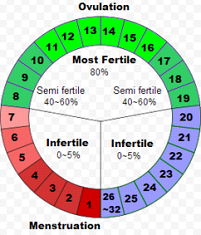Natural family planning or fertility awareness is sometimes the preferred method of many couples who don’t want to use prescribed birth control measures to avoid pregnancy. The calculation method requires the awareness of the changes during the menstrual cycle in order to determine a safe period to have sex. For the calculation method to be effective, women need to understand the three stages of the menstrual cycle, and fully understand who can or cannot use this method.
Three Stages of Menstrual Cycle
Knowing the three stages of your menstrual cycle will improve your chances of avoiding pregnancy. The length of the phases will vary between women and from cycle to cycle, although the average menstrual cycle is usually 28 days.
1. First Stage
This is called the follicular phase, and between day 2 and 14 your body will release hormones that make the eggs in your ovaries grow. Those hormones also help thicken the lining of your uterus to get ready for a fertilized egg.
2. Second Stage
The ovulatory phase of the menstrual cycle occurs in the middle of your cycle, and is the process where a mature ovarian follicle bursts releasing an egg cell (ovum) for fertilization. A woman has the best chance of getting pregnant around the days when ovulation occurs.
3. Third Stage
The luteal (premenstrual) phase starts on the day the egg is released from the egg follicle on the ovary (ovulation day). The luteal phase may occur any time from 16 to 28 days of a normal menstrual cycle.
Safe Period to Have Sex
1. What Is Safe Period?
Since sperm can live up to 3 to 5 days in a woman's reproductive tract, and the life span of the typical egg is only around 24 hours, the period one week prior and one week after the approximate day of ovulation is considered a fertile period. The ovulation day may vary for each woman, and can occur from days 12 to 19 of the cycle. The days apart from this are called the safe periods to have sex, where the fertilization does not take place.

2. How to Calculate the Safe Period?
Calculating the safest period in the menstrual cycle is simple. Here are the steps to follow:
- Know your lastp eriod first date.
- Determine the longest and shortest menstrual cycles by observing your menstrual cycle for last 6 months.
- The first week of a normal menstrual period lasting 26-32 days averagely are calculated as a safe period, when you consider the sperm cells 3 to 5 day life span in the female reproductive track. The postovulatory infertile period is calculated based on ovulation occurring on the 19th day. Therefore, fertilization can result until day 20 of the cycle, when taking into consideration the 24 hour life cycle of the egg. The results may vary from woman to woman since it is a calendar based method.
3. Who Can Use This Method?
If you consider using a safe period calculation to calculate a safe period to have sex, then note that the failure rate is around 3-4% annually, so make sure you understand the risks. If in the last 6 months your average menstrual cycleis between days 26 to 32, this calculation method can be effective. However, you should also discuss alternative birth control methods with your health care provider.
4. Who Can’t Use This Method?
For those women whose last 6 menstrual cycle averages do not fall within the 26 to 32 day time frame, they will not be able to use this calculation method. Furthermore, women who have recently had a child will needto wait until they have averaged 6 menstrual cycles after giving birth, to determine if they can use the calculator method to calculate a safe period to have sex. Take note that the calculator method is not recommended for teens or women who are premenopausal.
Other Ways to Avoid Pregnancy
1. For Men
- Condom: Usually made from latex (rubber), condoms prevent pregnancy by blocking the passage of sperm. It is a barrier method of contraception, and can only be used once. Condoms, when used with a spermicide, are the most effective method for reducing the risk of genital lesions, infectious genital discharges, and from the viruses that cause AIDS and sexually transmitted diseases (STD’s).
- Male sterilization: Also known as vasectomy, it’s a surgical procedure in which the tubes that carry sperm from the testicles are cut. The semen will no longer contain sperm, so conception cannot occur. Although the testicles continue to produce sperm, they eventually die and are absorbed by the body. However, the ability to get an erection and ejaculation does not disappear.
2. For Women
- Oral contraceptives: Also known as a birth control pill taken daily by mouth. It protects against pregnancy with the combined actions of the hormones estrogen and progestin. When these hormones are given in certain amounts, and at certain times in the menstrual cycle, they prevent the ovary from releasing an egg for fertilization.
- Diaphragm: Diaphragms are made of latex rubbers that block sperm from entering the uterus. The dome-shaped diaphragm is a barrier method of contraception that conforms to the shape and contours of the vagina, and must be fitted by your health care provider. Although diaphragms also require the use of a spermicidal cream or jelly, the device causes no discomfort to either partner.
- Implants: A long-term birth control option for women are contraceptive implants made up of small, flexible rods that are surgically implanted under the skin on the inside of the upper arm. Contraceptive implants work by releasing a steady, low dose of a progestational hormone that thickens cervical mucus, thins the lining of the uterus, and typically suppresses ovulation.
